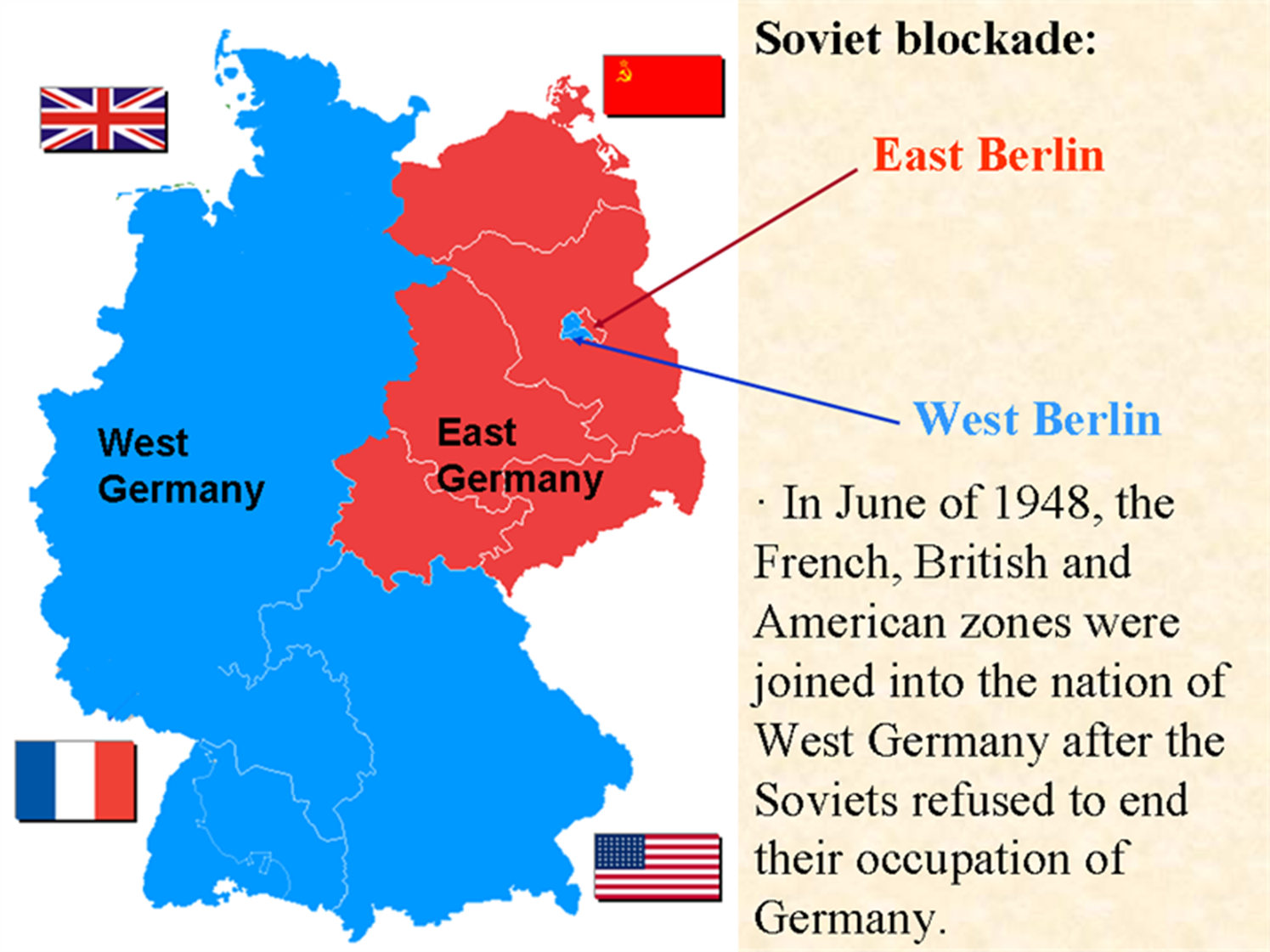22.4: The Cold War
- Page ID
- 173042
\( \newcommand{\vecs}[1]{\overset { \scriptstyle \rightharpoonup} {\mathbf{#1}} } \)
\( \newcommand{\vecd}[1]{\overset{-\!-\!\rightharpoonup}{\vphantom{a}\smash {#1}}} \)
\( \newcommand{\id}{\mathrm{id}}\) \( \newcommand{\Span}{\mathrm{span}}\)
( \newcommand{\kernel}{\mathrm{null}\,}\) \( \newcommand{\range}{\mathrm{range}\,}\)
\( \newcommand{\RealPart}{\mathrm{Re}}\) \( \newcommand{\ImaginaryPart}{\mathrm{Im}}\)
\( \newcommand{\Argument}{\mathrm{Arg}}\) \( \newcommand{\norm}[1]{\| #1 \|}\)
\( \newcommand{\inner}[2]{\langle #1, #2 \rangle}\)
\( \newcommand{\Span}{\mathrm{span}}\)
\( \newcommand{\id}{\mathrm{id}}\)
\( \newcommand{\Span}{\mathrm{span}}\)
\( \newcommand{\kernel}{\mathrm{null}\,}\)
\( \newcommand{\range}{\mathrm{range}\,}\)
\( \newcommand{\RealPart}{\mathrm{Re}}\)
\( \newcommand{\ImaginaryPart}{\mathrm{Im}}\)
\( \newcommand{\Argument}{\mathrm{Arg}}\)
\( \newcommand{\norm}[1]{\| #1 \|}\)
\( \newcommand{\inner}[2]{\langle #1, #2 \rangle}\)
\( \newcommand{\Span}{\mathrm{span}}\) \( \newcommand{\AA}{\unicode[.8,0]{x212B}}\)
\( \newcommand{\vectorA}[1]{\vec{#1}} % arrow\)
\( \newcommand{\vectorAt}[1]{\vec{\text{#1}}} % arrow\)
\( \newcommand{\vectorB}[1]{\overset { \scriptstyle \rightharpoonup} {\mathbf{#1}} } \)
\( \newcommand{\vectorC}[1]{\textbf{#1}} \)
\( \newcommand{\vectorD}[1]{\overrightarrow{#1}} \)
\( \newcommand{\vectorDt}[1]{\overrightarrow{\text{#1}}} \)
\( \newcommand{\vectE}[1]{\overset{-\!-\!\rightharpoonup}{\vphantom{a}\smash{\mathbf {#1}}}} \)
\( \newcommand{\vecs}[1]{\overset { \scriptstyle \rightharpoonup} {\mathbf{#1}} } \)
\( \newcommand{\vecd}[1]{\overset{-\!-\!\rightharpoonup}{\vphantom{a}\smash {#1}}} \)
Despite being permanent members of the UN Security Council, the divisions between the US and USSR undermined the possibility of global unity. By the late 1940s, the world was increasingly split into the two “camps” of the Cold War, a decades-long rivalry between the two postwar “superpowers,” the United States and the Soviet Union. As the decades moved on, both sides built enormous nuclear arsenals that would potentially lead to the extinction of the human species. (In U.S. History, the idea is often referred to as M.A.D.: Mutually Assured Destruction.) Both nations had enough of a collective self-preservation instinct that the conflict worked itself out in the form of technological and scientific rivalry, an enormous and ongoing arms race, and "proxy wars" fought elsewhere that did not directly draw both sides into a larger conflict.
Truman Doctrine
The Cold War was never 'declared', but rather consisted of doctrines and plans. In 1947, the US issued the Truman Doctrine, which pledged to help people resist communism wherever it appeared – the rhetoric of the doctrine was about the defense of free people who were threatened by foreign agents. Out of the doctrine came the idea of “containment,” of keeping communism “contained” to the countries it already had taken over. The immediate impetus was a conflict raging in Greece after WWII, in which the communist resistance movement sought to overthrow the right-wing, royalist government. Both the British and US supported the Greek government, However, the USSR did not lend any aid to the communist rebels, fearing that doing so could lead to a much larger conflict. Furious at what he regarded as another instance of western capitalist imperialism, Stalin pulled the USSR out of the Bretton Woods economic agreement in early 1948.
The Truman Doctrine was closely tied to the fear of what U.S. policy-makers called the “Domino Theory”, if one nation “fell” to communism, then the same ideology would spread to the surrounding countries. Thus, preventing a communist takeover anywhere, even in a comparatively small and militarily insignificant country, was essential from the perspective of U.S. foreign policy. From the 1950s through the 1980s, the policy would be especially important in politics, conflicts, and wars from Latin America to Southeast Asia.
Along with the Truman Doctrine, the United States introduced the Marshall Plan (1948), which involved providing enormous loans to European countries trying to rebuild from the war. At the same time, European states founded the Organization of European Economic Cooperation (OEEC), which required any country accepting loans to join. Stalin regarded the OEEC as a puppet of the US, and banned all countries under Soviet influence from participating. Simultaneously, the Soviets were busy extracting wealth and materials from Eastern Europe to help recover from their own war losses. The Marshall Plan, OEEC, and Soviet policy created a stark economic division between west and east: while Western Europe rapidly recovered from the war, the east remained poor and comparatively backwards.
Iron Curtain
By 1948, in the words of Winston Churchill, the “iron curtain” had truly fallen across Eastern Europe. With the aid of Soviet “advisers”, communists from Poland to Romania used terror tactics and legal bans to push non-communist parties and political organizations out. Soon, Eastern European states officially pledged to cooperate with the USSR. Practically speaking, every Eastern European country was controlled by a communist party that took its orders directly from Moscow, no independent political decision-making was allowed. By 1955, the Soviets had formalized their own military system with the Warsaw Pact, a web of military alliances comparable to NATO.

The major exception was Yugoslavia, where a genuine communist revolution occurred. During the war, an effective anti-German resistance was led by Yugoslav communists, and in the aftermath they succeeded in seizing power over the entire country. Tito, the communist leader of Yugoslavia, angrily broke with Stalin. Thus, Yugoslavia was a communist country, but not one controlled by the USSR.
In turn, Stalin's anger with Yugoslavia inspired the Soviets to carry out a series of purges against the communist leadership of the Eastern European countries under Soviet domination. Soviet agents sought “Titoists” who were supposedly undermining the strength of commitment to communism. Between 1948 and 1953, communist leaders were put on show trials, both in their own countries and sometimes after being hauled off to Moscow, where they were first tortured into confessing various made-up crimes and then executed.
At first, USSR made no overt attempts to sponsor communist takeovers outside of Eastern Europe. One exception occurred in 1948/1949, when the Soviets blockaded West Berlin. The western “zones” of Berlin remained in the hands of the US, Britain, and France, a strange relic of the immediate aftermath of the war. As Cold War tensions mounted, Stalin ordered the blockade of all supplies going to the western zones. In response, the US led a massive ongoing airlift of food and supplies for nearly a year while both sides studiously avoided armed confrontation. In the end, the Soviets abandoned the blockade, and West Berlin became a unique pocket of the Western camp in the midst of communist East Germany.


